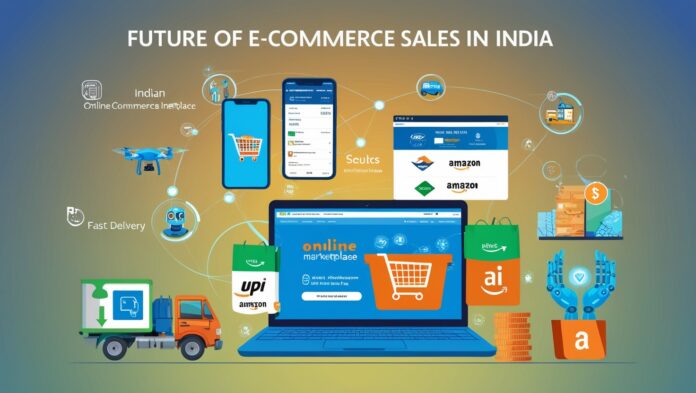Introduction: The e-commerce industry in India has been on a rollercoaster ride over the past decade. From being a niche market to becoming a major player in global online sales, the journey has been fascinating. But if you’re thinking, “How do I predict where it’s headed next?” you’re in the right place. Whether you’re a business owner, an entrepreneur, or just someone curious about India’s e-commerce future, understanding the trends and factors influencing this sector is essential.
In this post, I’ll walk you through some practical steps to analyze the future of e-commerce sales in India. We’ll keep it simple and conversational, just like we’re chatting over coffee.
1. Understand the Current Landscape
Before predicting the future, it’s important to have a firm grasp on where the industry stands today. Right now, India’s e-commerce market is booming, with more consumers opting to shop online than ever before. But why? The answer lies in several key factors:
- Smartphone Penetration: With affordable smartphones and cheaper internet, India’s online user base has skyrocketed. More people are shopping on mobile devices than ever before.
- Urbanization & Rural Growth: Not only are cities becoming more digitally connected, but rural areas are also tapping into the e-commerce space, widening the market.
- Digital Payments: Platforms like UPI (Unified Payments Interface) and digital wallets have made online shopping seamless and secure.
These factors are pushing India’s e-commerce growth, but to understand the future, we need to look a little deeper.
2. Identify Key Trends in Indian E-Commerce
The trends we see today give us hints about where things are headed. Some of these trends are:
- Omnichannel Shopping: Consumers now expect to seamlessly switch between online and offline shopping. Brands that blend these experiences well will thrive.
- Personalization: More online stores are offering personalized recommendations based on a shopper’s browsing and purchase history. This isn’t just a trend—it’s becoming an expectation.
- AI and Automation: From chatbots handling customer service to AI-driven analytics predicting shopping patterns, automation is slowly transforming the way businesses operate.
Real-life Example: Think about Flipkart. They’ve started integrating AI into their product recommendations, which helps them understand what you might be interested in before you even search for it. This personalized touch is a glimpse into the future of shopping.
3. Study Consumer Behavior Changes
Consumer behavior has always been a driving force in the e-commerce sector. One thing we’ve learned during the pandemic is that people love convenience. As more consumers adapted to online shopping during lockdowns, many of those habits stuck. Here are a few behavioral shifts:
- Trust in Online Shopping: More people, even in smaller towns, are now comfortable shopping online, thanks to improved logistics and faster delivery services.
- Demand for Faster Deliveries: Instant gratification is key. Consumers now expect faster, even same-day delivery. Companies investing in last-mile delivery solutions will stay ahead.
- Preference for Eco-Friendly Products: People are increasingly conscious of their environmental impact. Brands offering sustainable options will likely attract a growing customer base.
4. Evaluate the Role of Government Policies
India’s government has played a huge role in shaping the future of e-commerce. With initiatives like “Digital India” and “Make in India,” the government is encouraging the growth of local businesses and online platforms. But there are also regulatory challenges.
- Data Privacy Regulations: Stricter data protection laws are being introduced. While this is great for consumers, businesses will need to adapt to ensure they handle customer data responsibly.
- Foreign Investment Rules: The government has placed restrictions on how foreign e-commerce players can operate in India. This affects companies like Amazon, but also opens opportunities for local players to step up.
Practical Tip: Stay updated on any policy changes, as these can directly impact your business strategies.
5. Use Data Analytics to Predict Trends
Now, let’s get a bit practical. You can’t talk about the future of e-commerce without mentioning data. Analytics tools can help businesses understand patterns and make informed decisions.
Here’s how you can use data to your advantage:
- Track Customer Preferences: Analyzing purchase data can show which products are trending and which ones are falling out of favor. This can guide your inventory and marketing strategies.
- Monitor Website Traffic: By observing when and where users are most active, you can tailor promotions or product launches to peak times.
- Competitor Analysis: Keep an eye on your competitors. Tools like SEMrush or Ahrefs allow you to track their traffic, backlinks, and more, helping you understand their strategies.
Real-life Example: Amazon heavily uses data analytics to forecast demand. By analyzing browsing patterns, they can predict which products will be in high demand, allowing them to stock up in advance and ensure smooth delivery.
6. Look at the Bigger Global Picture
While India’s e-commerce market has its unique challenges and opportunities, it doesn’t exist in isolation. Global trends often influence local markets, and staying aware of what’s happening internationally can give you a broader perspective.
- Cross-border Commerce: More Indian consumers are buying from international websites, thanks to easier payment methods and shipping solutions.
- Blockchain in E-Commerce: Although still in its infancy, blockchain could revolutionize how e-commerce operates, especially in terms of secure payments and supply chain transparency.
Conclusion:
The future of e-commerce sales in India is bright but also evolving. As businesses, we need to stay ahead of the curve by understanding key trends, leveraging data, and keeping an eye on global shifts. But most importantly, success lies in focusing on what consumers want—convenience, personalization, and trust.
So, whether you’re a business owner, entrepreneur, or just someone passionate about the industry, now’s the perfect time to start planning for the future.



